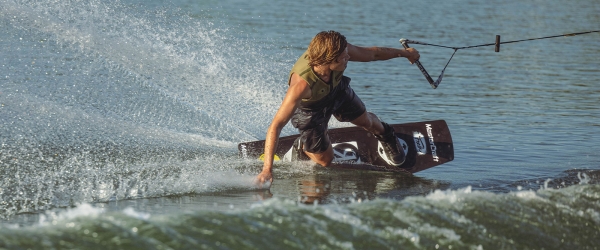Here are questions that customers have asked our experts and the advice that they recieved in return! Click here to send in our boating questions.
- How fast should I drive for wakeboarding? And how long should the rope be?
- Besides the mandatory safety equipment, do you recommend I carry anything else aboard my boat?
- What should I do when I start up my boat for the first time this spring?
- What are the rules for towing someone behind my boat?
- I have sticky zippers & snaps on my boat top. What do I do?
How fast should I drive for wakeboarding? And how long should the rope be?
Blake Rowsell of Team Fun answers these crucial questions. Professional wakeboarders ride at a speed between 24-26 mph. They also use a rope length of 75-85 feet. Both boat speed and rope length depend on the boat and the rider's ability. The short answer is that riders should start to ride at 10-15mph and as riders improve the boat speed can increase.
At Team Fun Wakeboard School, we tow beginner riders at a speed around 10-15 mph. This depends on the size and age of the rider. Wakeboarders who are not jumping over both wakes do not need to ride any faster than 15 mph. The rope length is not as important for beginners; however, we like to use a longer rope that is approximately 65 feet long to allow riders a larger landing area in between wakes. While riders are performing surface tricks, such as butter slides and surface 180s, the boat should be slowed down considerably (8 mph). At slower speeds, the surface tension of the water is reduced and it becomes easier to release the fin of the wakeboard.
Intermediate wakeboarders require slightly faster speeds. As the boat goes faster, the wake becomes narrower and easier to clear (jump over both wakes). We pull intermediate wakeboarders at approximately 18- 20 mph.
Long rope lengths put the rider in position for a wider wake. The further you move away from the back of the boat, the wider the wake is. To make jumping both wakes as easy as possible, we use a shorter rope. Approximately 50-55 feet of rope works best for riders attempting to jump over both wakes. As riders improve the rope length can be extended to allow riders to jump further and still land on the down side of the second wake. The goal is to have a combination where riders are able to comfortably jump over both wakes. Expert riders will begin to find what boat speed and rope length works for them. We recommend trying 22 mph and 65 feet of rope.
Mastercraft Boat Company has put a lot of research into creating a wake that maintains a good shape at all speeds and rope lengths. In addition, the introduction of cruise control devices has helped dramatically in enabling riders to chose and maintain a boat speed. This technology helps riders have more fun behind the boat.
When choosing a speed and rope length that works for you, remember that water is painful at high speeds, so start slow and work your way up. This is especially true for young children, slower is better. It only takes one hard fall to turn a child off wakeboarding. Knowledge of the proper speed signals will help communication between rider and driver and make for fun times on and off the water!
Besides the mandatory safety equipment, do you recommend I carry anything else aboard my boat?
Of course, as you've mentioned, every boat operator should be aware of the regulations on his/her vessel and make sure all of the necessary safety equipment is aboard before leaving the dock. The Canadian Safe Boating Council also recommends packing extra clothing in a watertight bag if you are planning to be on the water for more than a few hours. Weather can change quickly and if you are away from the shore without an extra sweater or dry clothes to change in to, your comfort and in extreme cases your health can be dramatically affected. The CSBC also recommends packing drinking water and high-energy snacks in case of heat stroke and other unexpected complications. Furthermore, a waterproof first-aid kit is a good idea on any boat. Even minor injuries can put a damper on a day on the water if an avoidable trip to the dock needs to be taken. Finally, the CSBC recommends carrying a tool kit with spare parts and tools and materials to temporarily stop hull leaks on long journeys. The easiest way to ensure a good day on the water is to be prepared before you leave the dock.
What should I do when I start up my boat for the first time this spring?
According to Gary Poole, Master Mechanic at Buckeye Marine, if you stored your boat yourself, you will need to give it a thorough cleaning and a coat of wax to get the winter grime and dust off, then follow the steps below.
If your boat has been professionally winterized all that will be necessary is to install the drain plug, remove the plastic bag around the propeller that protects the exhaust, and then charge and connect the battery.
Before starting your engine for the first time this season, remove the engine cowls or covers, looking for cracked and disconnected hoses, worn belts, loose fasteners or evidence of nests made by critters over the winter. If everything is A-okay, start the engine using the proper starting procedures and let it idle. Check the gauges to make sure it has sufficient oil pressure and that the temperature is within the recommended specifications. Visually inspect the engine for water, exhaust or fuel leaks. If the inspection is successful, close up the engine compartment or cowl, then take off from the dock and accelerate the engine slowly to half throttle. Cruise at half throttle for 5 to 10 minutes before accelerating further. This allows the engine to lubricate properly after being in storage. Now you can advance the throttle to higher speeds and take the boat for a good long cruise. It is important for the life of the battery to go on this cruise soon after it has been charged to stir up the electrolytes and build a lasting charge.
The worst thing you can do is not use the boat immediately once it comes out of storage. Think of this initial cruise as an awakening to stimulate the life back into your boat. When you return from your inaugural cruise, look in the engine compartment or under the cowl, checking again for water, gas or exhaust leaks. If you suspect any problems, contact us at the service department immediately.
What are the rules for towing someone behind my boat?
Blake Rowsell of Team Fun Watersports advises that there are very specific regulations for towing anyone, including skiers, wakeboarders, and tubers, behind your boat. The regulations, according to the Canadian Coast Guard are as follows:
1. A spotter must be onboard and there must be a seat on the boat for each person being towed. This means only watercraft designed to carry three or more people (driver, spotter, skier) may be used as a tow vessel.
2. There is a specific time period in which someone may be towed. Towing must take place between sunrise and one hour after sunset.
3. The watercraft doing the towing cannot be remotely controlled.
The Canadian Coast Guard offers other suggestions for the safety of those being towed. When dropping a person off, keep a safe distance from the shore and let the skier swing in to shore. Also when picking up someone who falls, turn the engine off before approaching closely.
I have sticky zippers & snaps on my boat top. What do I do?
Debbie Poole of Lakeside Custom Works recommends that you clean your snaps and zippers with plain water. Next, spray Captain Phab's Dry Teflon spray on the snaps and zippers. Dry Teflon also works well for stubborn locks or other stiff moving parts. Debbie also warns that you should take your time while putting your cover on and taking it off. Make sure you put each snap on individually and take it off the same way so that they don't get torn out. If you find that your snaps are getting loose, you should get them repressed to ensure longevity. This can be easily and quickly done by taking your top into Debbie or request that it be done over the course of the winter while it is in for storage!
If you have a question that you would like to ask one of our experts please email it to us by clicking here

